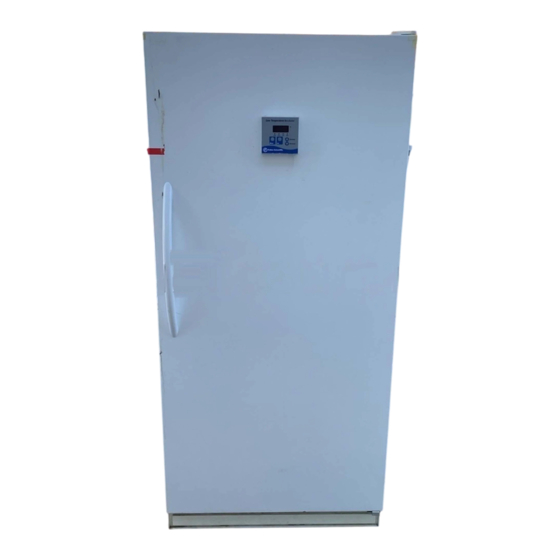
Table of Contents
Advertisement
Quick Links
Fisher Isotemp® Low Temperature Incubator
Model 307C Catalog Number 11-679-25C
Fisher Low Temperature Incubator offers laboratories precise
temperature control over the -10°C to 60°C range.
Performance meets requirements for the preservation of
vaccines, biologicals, incubation of bacterial cultures, and
determination of bio-chemical oxygen demand of sewage. The
extended operating temperature range also includes
temperatures associated with drug stability projects, dairy
product evaluation and entomological studies.
The spacious chamber accommodates up to 300 standard
BOD bottles, or similar containers. The 5 reinforced shelves
can handle up to 60 lbs of sample weight each.
Features include:
Ø5 Removable shelves
Ø1 Removable storage basket
Ø6 Molded door shelves
ØDoor Lock with key
ØMicroprocessor based temperature controller, with
temperature readout to .1°C
Ø3 Cooling control modes: High precision with cooling, High
precision without cooling and Frost free with variable cooling
ØSolid state relay for heater
ØOver/ under temperature safety relay and alarm Over
temperature thermostat
ØCompressor relay for energy conservation
ØCompressor overload relay
ØRTD temperature probe
ØProtected setpoint mode to avoid accidental change
ØConvenience outlet inside chamber, 2 amp
ØInterior light with door switch
WARNING
• This manual must be carefully read and thoroughly
understood before operating the unit, failure to follow
directions or precautionary measures could result in
serious adverse effects.
• This equipment must be used only as specified in these
instructions.
• This equipment is intended for indoor use only.
• This equipment must be earth grounded for safe operation.
•
Maximum ratings of accessories that may be plugged into
convenience outlet: Load current 2 Amps. @ 115VAC,
Leakage Current 250 micro Amps.
CAUTION
The aluminum evaporator and other portions of these units
should not be exposed to the corrosive effects of acidic or
caustic materials. Extreme care must be exercised if such
materials are stored within to prevent voiding the warranty.
This Incubator is NOT suitable for flammable material storage.
SPECIFICATIONS
Power Requirements:
115V, 8.9A, 60 Hz (Including 2 A for convenience outlet)
Dimensions:
Height:
Width:
Depth:
28.5 in (72cm)
Volume:
20.3 cu ft (0.58m
Shelf Data:
Capacity:
300 BOD bottles
Shipping Weight:
283 lb. (128 kg)
Operating Environment:
Temperature Range:
Humidity Range: 0% to 90% RH
Maximum Altitude:
Air clearances:
Overvoltage Category
Pollution Degree 2 (IEC664)
Performance Characteristics:
Operating Range:
Uniformity:
Stability:
Display Readability:
1
Per ASTM method E 1292-94, cooling modes 00 and 100
PACKING LIST
Qty
Item
1 Low Temperature Incubator
1 Instructions
UNPACKING and INSPECTION
NOTE: If damage is observed, keep the shipment intact
(including the carton and all packing material) and file a claim
with the final carrier.
INSTALLATION
The Low Temperature Incubator should be installed on a level,
stable floor. Use the adjustable feet to level the incubator.
Locate the unit so that there is at least 3 inches of clearance
around the sides, top and back to ensure sufficient ventilation.
Note: When cooling is enabled, heat is dissipated on sides of
unit resulting in side temperatures of 35 to 55°C. To prevent
heat build up within the unit, do not install it where it will be
exposed to strong sunlight, nor near radiators, furnaces, or
other sources of heat. Do not install the incubator where
flammable or corrosive atmospheres may exist. The Low
Temperature Incubator is not to be used out-of-doors or where
excessive moisture or contamination could cause degrading of
mechanical or electrical components.
1. Unbolt and remove the wooden slats underneath unit.
2. Remove all protective tape from doors and shelves.
3. Clean interior and exterior with warm soap and water.
Shipping tape residue can be removed using isopropyl alcohol.
4. Uncoil line cord from rear of unit. Connect the plug to a
power outlet that complies with the electrical requirements
specified on the unit's label and with proper safety ground
connection. If line cord replacement is necessary, use CSA
types: SJ, SJO or SJT, 16 GA, 3 cond. or equivalent.
70 in (179cm)
32 in (81cm)
3
)
5 in chamber, 6 on door, 1 basket
10°C to 40°C
6600 ft (2 km)
Back, top and sides 3.0" minimum
II (IEC664)
-10° to +60°C
1
±0.5°C
1
±0.2°C
0.1°C
Advertisement
Table of Contents

Subscribe to Our Youtube Channel
Summary of Contents for Fisher Scientific Fisher Isotemp 307C
- Page 1 Dimensions: Height: 70 in (179cm) Width: 32 in (81cm) Depth: 28.5 in (72cm) Fisher Isotemp® Low Temperature Incubator Volume: 20.3 cu ft (0.58m Shelf Data: 5 in chamber, 6 on door, 1 basket Model 307C Catalog Number 11-679-25C Capacity: 300 BOD bottles Fisher Low Temperature Incubator offers laboratories precise Shipping Weight: temperature control over the -10°C to 60°C range.
- Page 2 incubator is new or hasn't been operated for a long period of time. CONTROLS Power ON/OFF Switch: Located on back wall of chamber, is Controller operation: used to turn power (1) ON or (0) OFF to entire unit. Usually the only controller setting that is necessary to change is the chamber temperature control setpoint.
- Page 3 mode of operation that determines when the alarm is activated MAINTENANCE and if the control setpoint can be changed. Range 0.0 to 0.2. WARNING 0.0 Mode- Normal mode that allows the user to change To reduce the risk of electric shock, disconnect from setpoint.
- Page 4 1-800-395-5442 4. Note wire colors and positions on TB1 and TB2, then remove all wires from TB1 and TB2 and old controller. Fisher Scientific 5. Locate switch DS1 on lower left corner of new controller and 2000 Park Lane set the switches as follows: Pittsburgh, PA 15275 USA Set DS1-1 (A) to on (down) .










Need help?
Do you have a question about the Fisher Isotemp 307C and is the answer not in the manual?
Questions and answers